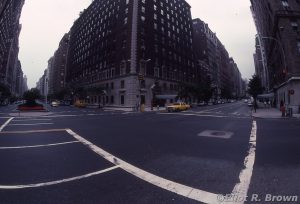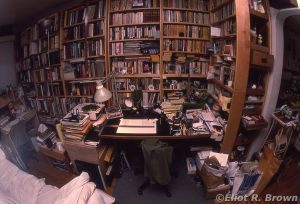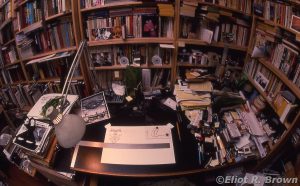I have wept and wailed for wider and wider wide-angle lenses all my photographic life. The 80s and 90s brought about a lower-cost revolution in what was regarded as “ultra-wides” and I was delighted. I charged a lesser King’s Ransom for the Spider-Man Holographic background image (a breath-taking story I will get to in another entry!) which neatly covered my first off-brand wide-angle lens.
Y’see… I was a Nikon Person. Yeah, I had a long-term borrowed Leica and that was nice but too expensive to repair. [Which I did once and is how I know! –Still-Stinging Brown] When Nikon introduced its first “affordable” professional camera body, the Nikon FM, I jumped. Generally, a 50mm lens is considered a “first lens.” So, I bit and bought.
Soon, dissension sunk in. I was stuffed into a “normal” box—well, that’s what the photographic industry considers a 50—a “normal” lens, about the degree of distortion that the human eyeball perceives. Some of you out there might scoff and sneer, “Brown, the human eye can see 180°, to the left and the right at once! The human eye’s effective lens equivalent is 7mm.” Sure. The 50mm lens cuts out the central area of that imaginary left-to-right image and jams it into your camera.
But, I assure you, that’s not enough. Oh, yeah, rag dolls on rusty garbage cans, busted picket fences vanishing in a snow drift or a reflected image of a person in a street puddle. Then a 50mm is fine. But I like to step back. Get the Big Picture.
Here is an example of that Big Picture!
I am standing on Manhattan’s fabulous Park Avenue, I think around 75th Street (not sure!) and you can see down Park and up the side street all in one shot. Okay, ma-a-aybe a bit extreme, but under the right circumstances, really nice.
What does this have to do with Marvel?
I had a Marvel job and a side-gig that I felt both needed a super-wide look. I was in no position to pony up the $1500 necessary to buy a 15mm lens, so I rented it.
Experienced equipment renters know, for a “one-day” rental, you pick up the item on a Friday and return it on a Monday. I know, sneaky; but it’s the way things are set up. I did those jobs over that weekend but—I had this swell lens at my disposal.
So! Set it up and bounced the flash off the ceiling—here, in all its ignominy, is my Manhattan Studio Apartment in about 1988. One can make out a lot of neatness. Much more neat than any other work environment.
The single craziest thing in retrospect was that I built all those shelves in that apartment, including the large slide-out drawers on the end—full of construction tools. Note the effect of the super-wide—it sure makes the place look larger. That wall was 15-feet, 3-inches wide.
Speaking of crowded—I was married at this point! Oh my, stories of “not wanting to tick off the normally patient wife” started right here. In this tiny micro-miniature Studio apartment, I introduced my darling bride, Arlene Puentes, to the wonders of scritchy-scratchy pencil and inking noises all day long. How did we do it? Headphones!
In this somewhat closer shot, you can just make out my Sony reversing Walkman. I made tapes of hot tunes (have to thank my old comrade in music and many other things, Mike Carlin, for his new wave taste in music) and as they played, my brain could drift along. I could forget the aches and pains of sitting still for hours on end, my head hanging over the art. When I hear, for example, She Blinded Me With Science three times, that’s when you stood up and had some food, perhaps look into the middle distance…
My darling bride could sit on the couch, visible to image left is where we would turn sideways and watch TV – yes! With headphones.
I still have this drafting table—but it’s essentially buried under notes, aged paperwork, model parts (plastic model kit “parts” I rush to assure you) and dust. At the top you will note a set of Castel “technical fountain pens” capable of giving me that hard line I so adore. The shelf at the same level as the table are my set of Robert A. Heinlein paperbacks. [The Dean of Science Fiction—still relevant today; in The Moon Is A Harsh Mistress, Mr. Heinlein came that close to describing and using the internet as we know it today—plus the story is an analog of the American Revolution! –Sci-Fi Brown] I have several pictures of my most important people, such as Rana and Kara my sisters and Jack Morelli, Mark Chiarello—all serve to remind me to think of people once in a while.
Those tech drawings can give you the jim-jams after a full day!


